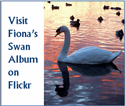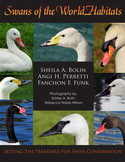Swans Through the Seasons
The 4 Ambleside Kids usually start their day all together – three side-by-side, and one never far away. An occasional raised wing now shows white underneath. Their feathers will continue to whiten over the coming year and by next summer the taupe tones will be completely replaced by the snowy feathers of a mature swan.
Their black bills will morph into gray-pink and eventually turn into the orange of the other adult swans, with a full-sized “knob” that is always a bit larger in males.
At almost 5 months, they still “peep!” but if you stay awhile, you’re bound to hear one or two of those unmistakable “whoopee cushion” snorts that also remind us they really are still …just kids. It will be at least 3 months before they have the deep, resonant snort of an adult swan.
Like any growing kids, they love to eat! Their diet consists of mostly leafy parts of aquatic vegetation, algae and roots from the lagoon, as well as insects and in the spring, those luscious gourmet treats…. tadpoles! In winter, when there is less natural growth in the lagoon, the Wildlife Technician adds a supplement of grain.
Swans feed in deeper water than ducks and other birds that share the lagoon, so they don’t compete with them for food – in fact, food is made more accessible to other birds by swans because parts of the plant matter they eat float to the surface while the swans are feeding.

Swans Through the Seasons is powered by
Tetra-WebBBS 5.30 Beta © 2006-2007 Tetra-Team






